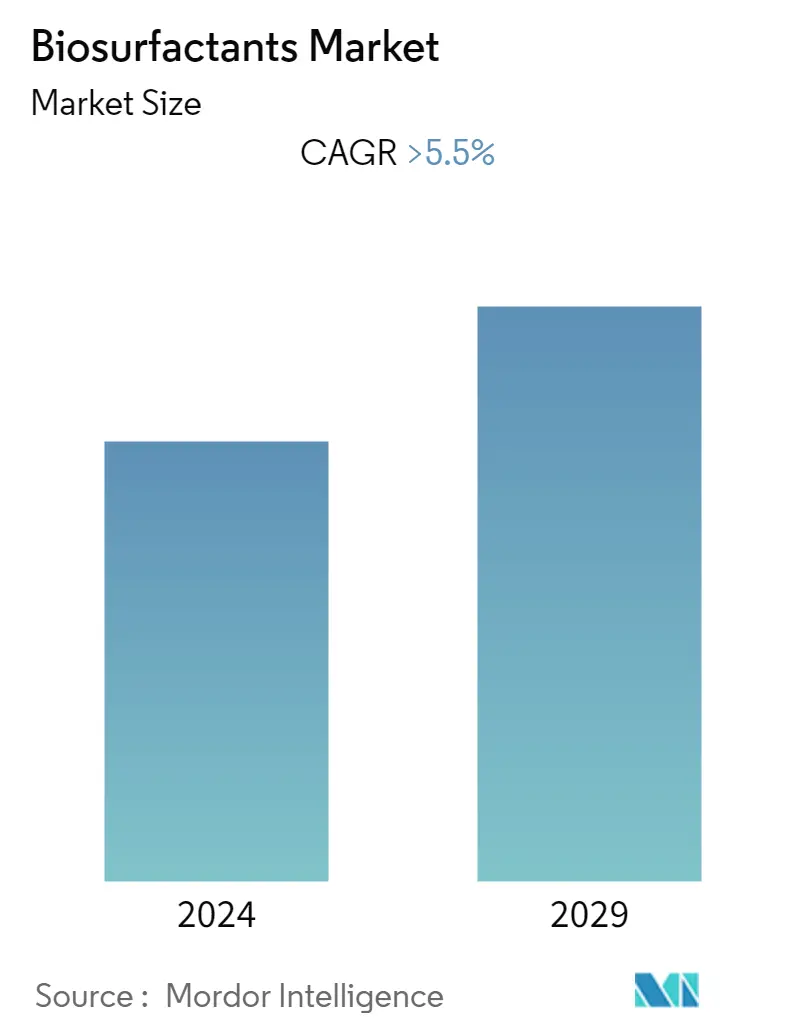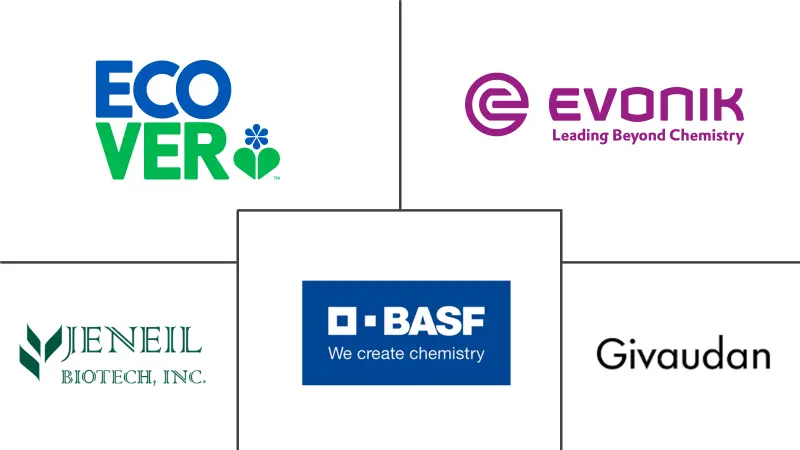
| Study Period | 2019 - 2029 |
| Base Year For Estimation | 2023 |
| Forecast Data Period | 2024 - 2029 |
| CAGR | 5.50 % |
| Fastest Growing Market | Asia Pacific |
| Largest Market | Europe |
| Market Concentration | High |
Major Players
*Disclaimer: Major Players sorted in no particular order |
Biosurfactants Market Analysis
The biosurfactants market is projected to register a CAGR of over 5.5% during the forecast period.
The COVID-19 pandemic negatively impacted the market in 2020. However, consciousness regarding personal hygiene and clean surroundings has increased in the current situation, stimulating the demand for personal and household cleaning products and enhancing the market growth of biosurfactants.
- Over the short term, the growing personal care industry in Asia-Pacific and rising consumer inclination toward using bioproducts are expected to drive the market's growth.
- High production costs are likely to hinder the market's growth.
- Growing innovation in the production methods of the biosurfactants will optimize the overall cost of their products which is further expected to stage lucrative growth opportunities for the growth of the market studied.
- The Europe region is expected to dominate the market. However, Asia-Pacific is likely to witness the highest CAGR during the forecast period.
Biosurfactants Industry Segmentation
Biosurfactants are surface compounds produced by microorganisms, including bacteria, yeast, and fungi. It has the potential to substitute synthetic surfactants because of its low toxicity and specificity property. The biosurfactants market is segmented by product type, application, and geography. By product type, the market is segmented into glycolipids, phospholipids, surfactin, lichenysin, polymeric biosurfactants, and other product types. By application, the market is segmented into detergents and industrial cleaners, cosmetics (personal care), food processing, oilfield chemicals, agricultural chemicals, textiles, and other applications. The report also covers the market size and forecasts for the biosurfactants market in 16 countries across the major regions. For each segment, the market sizing and forecasts have been done based on revenue (USD million).
| Glycolipid (Rhamnolipids, Trehalolipids, and Sophorolipids) |
| Phospholipids |
| Surfactin |
| Lichenysin |
| Polymeric Biosurfactants |
| Other Product Types |
| Detergents and Industrial Cleaners |
| Cosmetics (Personal Care) |
| Food Processing |
| Oilfield Chemicals |
| Agricultural Chemicals |
| Textiles |
| Other Applications |
| Asia-Pacific | China |
| India | |
| Japan | |
| South Korea | |
| ASEAN Countries | |
| Rest of Asia-Pacific | |
| North America | United States |
| Canada | |
| Mexico | |
| Europe | Germany |
| United Kingdom | |
| France | |
| Italy | |
| Spain | |
| Rest of Europe | |
| South America | Brazil |
| Argentina | |
| Rest of South America | |
| Middle-East and Africa | Saudi Arabia |
| South Africa | |
| Rest of Middle-East and Africa |
Biosurfactants Market Size Summary
The biosurfactants market is experiencing a positive trajectory, driven by increasing awareness of personal hygiene and environmental concerns. The shift from chemical to biosurfactants is fueled by their low toxicity, high biodegradability, and ability to be derived from renewable resources, making them a preferred choice in personal and household cleaning products. The market is poised for growth, particularly in the Asia-Pacific region, where the personal care industry is expanding and consumer preference for bioproducts is rising. However, high production costs remain a challenge, though innovations in production methods are expected to optimize costs and create lucrative opportunities for market expansion. Europe currently dominates the market, with significant demand from countries like Germany, the United Kingdom, France, and Italy, which are major consumers of soaps, detergents, and cosmetics.
The biosurfactants market is characterized by a consolidated landscape, with major players such as Evonik Industries AG, BASF SE, Ecover, Jeneil, and Givaudan holding substantial market shares. These companies are actively investing in sustainable production facilities and developing bio-based surfactants to meet the growing demand for eco-friendly alternatives. For instance, Evonik Industries AG is constructing a rhamnolipid production facility in Slovakia, while BASF SE has introduced Plantapon Soy, a bio-based surfactant derived from soy protein. Such developments underscore the industry's commitment to sustainability and innovation, positioning biosurfactants as a viable alternative to traditional chemical surfactants in various applications, including personal care and cosmetics.
Biosurfactants Market Size - Table of Contents
1. MARKET DYNAMICS
-
1.1 Drivers
- 1.1.1 Growing Personal Care Industry in Asia-Pacific
- 1.1.2 Rising Consumer Inclination Toward the Use of Bioproducts
-
1.2 Restraints
- 1.2.1 High Production Cost
- 1.2.2 Other Restraints
- 1.3 Industry Value Chain Analysis
-
1.4 Porter's Five Forces Analysis
- 1.4.1 Bargaining Power of Suppliers
- 1.4.2 Bargaining Power of Consumers
- 1.4.3 Threat of New Entrants
- 1.4.4 Threat of Substitute Products and Services
- 1.4.5 Degree of Competition
2. MARKET SEGMENTATION (Market Size in Value)
-
2.1 Product Type
- 2.1.1 Glycolipid (Rhamnolipids, Trehalolipids, and Sophorolipids)
- 2.1.2 Phospholipids
- 2.1.3 Surfactin
- 2.1.4 Lichenysin
- 2.1.5 Polymeric Biosurfactants
- 2.1.6 Other Product Types
-
2.2 Application
- 2.2.1 Detergents and Industrial Cleaners
- 2.2.2 Cosmetics (Personal Care)
- 2.2.3 Food Processing
- 2.2.4 Oilfield Chemicals
- 2.2.5 Agricultural Chemicals
- 2.2.6 Textiles
- 2.2.7 Other Applications
-
2.3 Geography
- 2.3.1 Asia-Pacific
- 2.3.1.1 China
- 2.3.1.2 India
- 2.3.1.3 Japan
- 2.3.1.4 South Korea
- 2.3.1.5 ASEAN Countries
- 2.3.1.6 Rest of Asia-Pacific
- 2.3.2 North America
- 2.3.2.1 United States
- 2.3.2.2 Canada
- 2.3.2.3 Mexico
- 2.3.3 Europe
- 2.3.3.1 Germany
- 2.3.3.2 United Kingdom
- 2.3.3.3 France
- 2.3.3.4 Italy
- 2.3.3.5 Spain
- 2.3.3.6 Rest of Europe
- 2.3.4 South America
- 2.3.4.1 Brazil
- 2.3.4.2 Argentina
- 2.3.4.3 Rest of South America
- 2.3.5 Middle-East and Africa
- 2.3.5.1 Saudi Arabia
- 2.3.5.2 South Africa
- 2.3.5.3 Rest of Middle-East and Africa
Biosurfactants Market Research FAQs
What is the current Biosurfactants Market size?
The Biosurfactants Market is projected to register a CAGR of greater than 5.5% during the forecast period (2025-2030)
Who are the key players in Biosurfactants Market?
BASF SE, Evonik Industries AG, Givaudan, Ecover and Jeneil are the major companies operating in the Biosurfactants Market.


